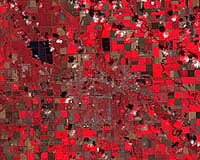 |
Montpellier, France (AFP) Sept 17, 2009 Pesticides, viruses, industrialised farming, fungus... what on Earth is killing our bees? That's the big question being asked at Apimondia, the 41st world apiculture congress, where 10,000 beekeepers, entomologists and other actors in the honey business are gathered in this southern French city until Sunday. Across parts of North America and swathes of Europe, but also now in patches of Asia, bee hives have been struck by a mysterious ailment dubbed Colony Collapse Disorder (CCD). At normal times, bee communities naturally lose around five percent of their numbers. But in CCD, a third, a half -- sometimes even 90 percent -- of the insects can be wiped out. Eerily, no bodies are typically found near the hive. The phenomenon is alarming for beekeepers, many of them small-scale operators or hobbyists, who lack the clout and subsidy support that other agricultural sectors enjoy. But food experts and environmental scientists are also worried. The Western honey bee is a vital link in the food chain, fertilising nearly 100 kinds of crops. Around a third of the food on our plates gets there thanks to Apis mellifera. By some estimates, this unseen, unsung work is worth more than 200 billion dollars a year, often through hives that are trucked to monoculture farms to do pollinating magic at specific times of the year. Wild bees, bats and other pollinators are simply not numerous enough to do the trick. So when honey bees and beekeeping are devastated, the impact for large-scale agricultural production is clear. "In China, fruit farmers in Sichuan are having to hand-pollinate their orchards," says Henri Clement, president of the National Union of French Beekeepers. Despite intense investigation, the cause of CCD remains unclear. Mooted culprits include a blood-sucking mite called varroa; a single-celled fungal parasite called Nosema cerenae that causes bee dystentery and pesticides used in fields that are pollinated by bees. Fingers in Europe have also pointed at an intruder, the Asian hornet, Vespa velutina, which lurks near hives and captures the poor honey bee in flight and devours it. Other proferred explanations include poor nutrition -- that mega farms, stripped of hedgerows and wild flowers, and spreading suburbs, with their concrete, roads and lawns, are depriving bees of a decent diet. Despite the many suspects, there has been no conviction, or at least none that singly explains why bee colonies should be collapsing in so many parts of the world at the same time. Climate change may also be an aggravating factor, say some experts. One possibility is that CCD is a complex web of factors. Last month, entomologists at the University of Illinois reported that bees in CCD-ravaged hives had high levels of damaged ribosomes -- a key protein-making machine within cells. Their ribosomes appear to have been hijacked by so-called picornia-like viruses, which seize control of cellular machinary to make it crank out only viral components. Picorna-like viruses are carried by the varroa mite, which has spread by being accidentally introduced through commercial transactions of bees. "If your ribosome is compromised, then you can't respond to pesticides, you can't respond to fungal infections or bacteria or inadequate nutrition because the ribosome is central to the survival organism," said researcher May Berenbaum. Meanwhile, researchers at Britain's University of Leeds have begun a three-year study to see if the bees' decline could have an earthier cause -- a lack of variety in the sex life of queen bees. They are investigating whether a decreasing number of potential mates means colonies are becoming less genetically diverse and more prone to disease. Share This Article With Planet Earth
Related Links Farming Today - Suppliers and Technology
 Snapshots From Space Cultivate Fans Among Midwest Farmers
Snapshots From Space Cultivate Fans Among Midwest FarmersGrand Forks ND (SPX) Sep 17, 2009 Noreen Thomas' farm looks like a patchwork quilt. Fields change hue with the season and with the alternating plots of organic wheat, soybeans, corn, alfalfa, flax, or hay. Thomas enjoys this view from hundreds of miles above Earth's surface - not just for the beauty, but the utility. She is among a growing group of Midwest farmers who rely on satellite imagery from Landsat to maximize thei ... read more |
|
| The content herein, unless otherwise known to be public domain, are Copyright 1995-2009 - SpaceDaily. AFP and UPI Wire Stories are copyright Agence France-Presse and United Press International. ESA Portal Reports are copyright European Space Agency. All NASA sourced material is public domain. Additional copyrights may apply in whole or part to other bona fide parties. Advertising does not imply endorsement,agreement or approval of any opinions, statements or information provided by SpaceDaily on any Web page published or hosted by SpaceDaily. Privacy Statement |